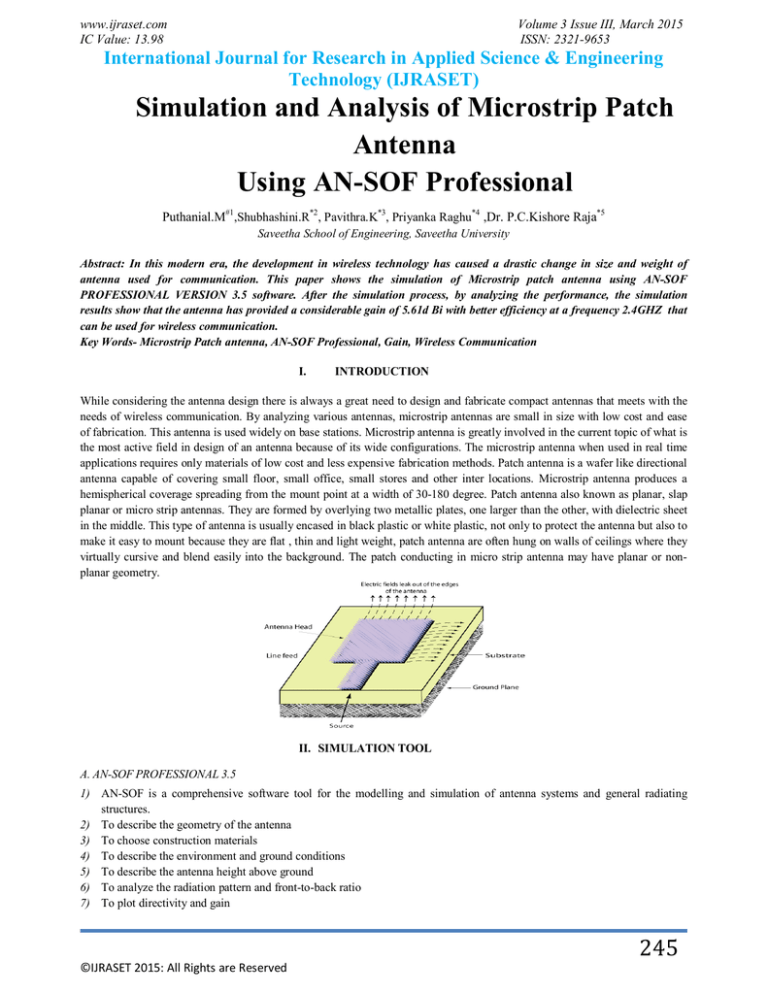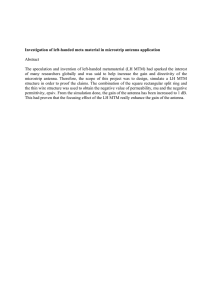
www.ijraset.com
IC Value: 13.98
Volume 3 Issue III, March 2015
ISSN: 2321-9653
International Journal for Research in Applied Science & Engineering
Technology (IJRASET)
Simulation and Analysis of Microstrip Patch
Antenna
Using AN-SOF Professional
Puthanial.M#1,Shubhashini.R*2 , Pavithra.K*3, Priyanka Raghu*4 ,Dr. P.C.Kishore Raja*5
Saveetha School of Engineering, Saveetha University
Abstract: In this modern era, the development in wireless technology has caused a drastic change in size and weight of
antenna used for communication. This paper shows the simulation of Microstrip patch antenna using AN-SOF
PROFESSIONAL VERSION 3.5 software. After the simulation process, by analyzing the performance, the simulation
results show that the antenna has provided a considerable gain of 5.61d Bi with better efficiency at a frequency 2.4GHZ that
can be used for wireless communication.
Key Words- Microstrip Patch antenna, AN-SOF Professional, Gain, Wireless Communication
I.
INTRODUCTION
While considering the antenna design there is always a great need to design and fabricate compact antennas that meets with the
needs of wireless communication. By analyzing various antennas, microstrip antennas are small in size with low cost and ease
of fabrication. This antenna is used widely on base stations. Microstrip antenna is greatly involved in the current topic of what is
the most active field in design of an antenna because of its wide configurations. The microstrip antenna when used in real time
applications requires only materials of low cost and less expensive fabrication methods. Patch antenna is a wafer like directional
antenna capable of covering small floor, small office, small stores and other inter locations. Microstrip antenna produces a
hemispherical coverage spreading from the mount point at a width of 30-180 degree. Patch antenna also known as planar, slap
planar or micro strip antennas. They are formed by overlying two metallic plates, one larger than the other, with dielectric sheet
in the middle. This type of antenna is usually encased in black plastic or white plastic, not only to protect the antenna but also to
make it easy to mount because they are flat , thin and light weight, patch antenna are often hung on walls of ceilings where they
virtually cursive and blend easily into the background. The patch conducting in micro strip antenna may have planar or nonplanar geometry.
II. SIMULATION TOOL
A. AN-SOF PROFESSIONAL 3.5
1) AN-SOF is a comprehensive software tool for the modelling and simulation of antenna systems and general radiating
structures.
2) To describe the geometry of the antenna
3) To choose construction materials
4) To describe the environment and ground conditions
5) To describe the antenna height above ground
6) To analyze the radiation pattern and front-to-back ratio
7) To plot directivity and gain
245
©IJRASET 2015: All Rights are Reserved
www.ijraset.com
IC Value: 13.98
Volume 3 Issue III, March 2015
ISSN: 2321-9653
International Journal for Research in Applied Science & Engineering
Technology (IJRASET)
8) To analyze impedance and SWR (Standing Wave Ratio)
9) To predict bandwidth
III.
ANTENNA DESIGN
In the design of a Microstrip antenna, the dielectric substrate used in it plays a major role. In this design process, RT DUROID
5870 is used as a dielectric material. RT DUROID is a Glass Microfibre Reinforced PTFE (polytetrafluoroethylene) composite,
this substrate has low loss tangent and it produce good resistance to chemical, solvent and reagents. It has a dielectric constant
2.2, it is low and gives a better performance than that of a substrate which has a high dielectric constant and it’s loss tangent is
0.0004. The following estimations have to be made when the antenna is designed.
Effective dielectric constant (€reff)
Height of dielectric substrate (H)
Width of the radiating patch (W)
Length of the radiating patch (L)
The method of analysis used here is the cavity model which gives more accurate results. The below calculations were also done
while designing the Microstrip patch antenna using An-sof professional software. The feeding method used here is the edge feed.
The number of facets used for patch is 11x11.
Line feed length > 25mm
Line feed width < 1mm
SINGLE FREQUENCY
2.4 GHZ
Substrate dimension along ‘X’
80-82 mm
Substrate dimension along ‘Y’
150-151mm
Patch dimension along ‘X’
11.057mm
Patch dimension along ‘Y’
-4.4355mm
IV.
SIMULATION RESULTS
The An-sof Professional sotware runs Far-Field pattern, Far- Field spectrum, Near E-Field Pattern, Near E-Field spectrum, Near
H-Field Pattern, Near H- Field spectrum of the antenna designed in it. These can be viewed in 2D polar plot and 2D rectangular
plot. The radiation pattern, Far- Field Pattern, and the current distribution of Microstrip antenna designed at 2.4GHZ is given
below:
Fig 1: Description Screen
246
©IJRASET 2015: All Rights are Reserved
www.ijraset.com
IC Value: 13.98
Volume 3 Issue III, March 2015
ISSN: 2321-9653
International Journal for Research in Applied Science & Engineering
Technology (IJRASET)
Fig 2: Patch antenna designed in An-sof Professional V3.5
Fig 3: 3D Radiation Pattern
Fig 4: Directivity graph of Microstrip patch antenna in polar plot
247
©IJRASET 2015: All Rights are Reserved
www.ijraset.com
IC Value: 13.98
Volume 3 Issue III, March 2015
ISSN: 2321-9653
International Journal for Research in Applied Science & Engineering
Technology (IJRASET)
Fig 5: Far Field Pattern (2D rectangular plot)
Fig 6: Current Distribution ( Imaginary part)
248
©IJRASET 2015: All Rights are Reserved
www.ijraset.com
IC Value: 13.98
Volume 3 Issue III, March 2015
ISSN: 2321-9653
International Journal for Research in Applied Science & Engineering
Technology (IJRASET)
V.
CONCLUSION
The Microstrip Patch antenna is simulated using An-sof Professional version 3.5. It has achieved a gain of 5.61d Bi at a
resonance frequency 2.4GHZ. The directivity of the antenna is also found to be 5.55 d Bi. The main aim of this paper is to
simulate a Microstrip patch antenna and to analyze it’s 3D radiation pattern, gain, directivity, power density. The simulated
antenna can be fabricated and can be used to capture electromagnetic energy from the RF signals that is radiated by wireless
communication systems around 2.4GHZ.
VI.
SUMMARY
Dr. P.C Kishore Raja, Professor and Head, Electronics and Communication Engineering Department, Saveetha School of
Engineering, Saveetha University, Chennai
Puthanial. M is pursuing her PhD in Wireless communication related work in the area of smart antennas under the guidance of
Dr.P. C. Kishore Raja.
Shubhashini.R, Pavithra.K and Priyanka Raghu, Undergraduate students from Electronics and Communication Engineering
Department worked closely on the paper and currently working on their projects using softwares- EZNEC, ADS and HFSS.
REFERENCES
[1]
[2]
[3]
[4]
[5]
[6]
[7]
[8]
[9]
[10]
[11]
[12]
[13]
[14]
[15]
[16]
[17]
[18]
R. E. Sorace, V. S. Reinhardt, and S. A. Vaughn, “High-speed digital-to-RF converter,” U.S. Patent 5 668 842, Sept. 16, 1997.
(2002) The IEEE website. [Online]. Available: http://www.ieee.org/
M. Shell. (2002) IEEEtran homepage on CTAN. [Online]. Available: http://www.ctan.org/tex-archive/macros/latex/contrib/supported/IEEEtran/
FLEXChip Signal Processor (MC68175/D), Motorola, 1996.
“PDCA12-70 data sheet,” Opto Speed SA, Mezzovico, Switzerland.
A. Karnik, “Performance of TCP congestion control with rate feedback: TCP/ABR and rate adaptive TCP/IP,” M. Eng. thesis, Indian Institute of Science,
Bangalore, India, Jan. 1999.
J. Padhye, V. Firoiu, and D. Towsley, “A stochastic model of TCP Reno congestion avoidance and control,” Univ. of Massachusetts, Amherst, MA,
CMPSCI Tech. Rep. 99-02, 1999.
Wireless LAN Medium Access Control (MAC) and Physical Layer (PHY) Specification, IEEE Std. 802.11, 1997.
J. D. Kraus, Antennas, 2nd ed., Mc Graw Hill International, 1988.
M. Bouhorma, A. Benahmed, F. Elouaai, A. Astito, and A. Mamouni, “Study of EM interaction between human head and mobile cellular phone,” in Proc.
Information and Communication Technologies International Symposium, Tetuan, Morocco, 3-6 June 2005.
M. Bouhorma, M. Benahmed, F. Elouaai, H. Drissi, and A. Mamouni, “Evaluation of the SAR distribution in the human head for cellular phones,” in
Proc. IWWCUCA, Val-d'OrQuebec, Canada, June, 6th and 7th 2005.
D. Manteuffel, A. Bahr, D. Heberling, and I. Wolff, “Design considerations for integrated mobile phone antennas,” in Proc. 11th Int. Conf. Antennas
Propagat., Apr. 17–20, 2001, pp.252–256.
S. Khalatbari, D. Sardari, A. A.Mirzaee, and H. A. Sadafi, “Calculating SAR in two models of the human head exposed to
mobile phones radiations at 900 and 1800 MHz”, in Proc. Progress In Electromagnetic Research Symposium, Cambridge, USA, vol. 2, no. 1, March 2629 2006, pp. 104-109.
M. B. Ahemad, M. Bouhorma, F. Elouaai, and A. Mouni, “Design of new multi standard patch antenna GSM/PCS/UMTS/HIPERLAN for mobile
cellular phones,” Europian Journal of Scientific Research, vol. 32, no. 2, pp. 151-157, 2009.
H. K. Gupta, P. K. Singhal, P. K. Sharma, and V. S. Jadun, “Slotted circular microstrip patch antenna designs for multiband application in wireless
communication,” International Journal of Engineering & Technology, Science Publishing Coroperation, vol. 3, no. 1, pp. 158-167, 2012
H. K. Gupta and P. K. Singhal, “Patch antennas designs with different shaped defect ground structure pattern in efficient rectenna design for wireless
power transmission,” IJECCT, vol. 3, no. 1.
C. Balinies, “Antenna theory,” Wiley, 2nd addition ch. 14, 1997.
(2012). CST Computer Simulation Technology. [Online]. Available: http://www.cst.com/content/products/mws/overview.aspx
249
©IJRASET 2015: All Rights are Reserved


